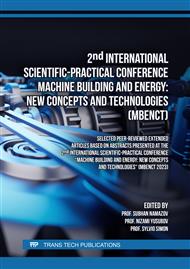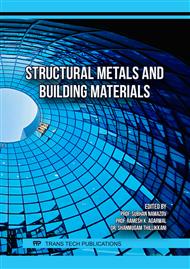[1]
S.A. Tobias and W. Fishwick, "A theory of Regenerative chatter," The Engineer-London, 1958.
Google Scholar
[2]
J. Tlusty and M. Polacek, "The Stability of Machine Tools against Self Excited Vibrations in Machining," International research in production engineering, ASME, 1963, pp.465-474.
Google Scholar
[3]
D. Montgomery and Y. Altintas, "Mechanism of Cutting Force and Surface Generation in Dynamic Milling," ASME, Journal of Engineering for Industry, Vol. 113, No. 2, 1991, pp.160-168.
DOI: 10.1115/1.2899673
Google Scholar
[4]
Y. Altintas, D. Montgomery and E. Budak, "Dynamic Peripheral Milling of Flexible Structures," ASME Journal of Engineering for Industry, Vol. 114, No. 2, 1992, pp.137-145.
DOI: 10.1115/1.2899766
Google Scholar
[5]
E. Budak and A. Altintas, "Modelling and Avoidance of Static form Errors in Peripheral Milling of Plates," International Journal of Machine Tools and Manufacture, Vol. 35, No. 3, 1993, pp.459-476.
DOI: 10.1016/0890-6955(94)p2628-s
Google Scholar
[6]
Bashegurov, S. V., Nasybullin, F. F., Khusainov, R. M., Faskhieva, Z. R. "Ensuring the safety of operation of the truck with the semi-trailer". Paper presented at the IOP Conference Series: Materials Science and Engineering, , 2019, 632(1)
DOI: 10.1088/1757-899X/632/1/012017
Google Scholar
[7]
Khusainov, R.M., Yurasov, S.Y., Kazargel'dinov, R.R. " Preparations for production in unigraphics NX software", Russian Engineering Research, 2017, 37(4), 363-366
DOI: 10.3103/S1068798X1704013X
Google Scholar
[8]
Krastyaninov, P. M., Khusainov, R. M. "Selection of equipment for machining processing of parts using NX and TEAMCENTER programs", Paper presented at the IOP Conference Series: Materials Science and Engineering, 2016, 134(1)
DOI: 10.1088/1757-899x/134/1/012041
Google Scholar
[9]
E. Budak and Y. Altintas, "Analytical Prediction of Chatter Stability in Milling—Part I: General Formulation," Journal of Dynamic Systems, Transactions of the ASME, Vol. 120, No. 1, 1998, pp.31-36.
DOI: 10.1115/1.2801318
Google Scholar
[10]
Y. Altintas and E. Budak, "Analytical Prediction of Stability Lobes in Milling," Annals of the CIRP, Vol. 44, No. 1, 1995, pp.357-362.
DOI: 10.1016/s0007-8506(07)62342-7
Google Scholar
[11]
Y. Altintas, "Manufacturing Automation—Metal Cutting Mechanics, Machine Tool Vibration and CNC Design," Cambridge University, 2000. ISBN-13: 978-0521659734.
DOI: 10.1017/cbo9780511843723
Google Scholar
[12]
T. Insperger and G. Stépán, "Stability of High-Speed Milling," Proceedings of the 2000 ASME International Mechanical Engineering Congress and Exposition, N o. AMD-241, Orlando, Florida, 2000, pp.119-123.
Google Scholar
[13]
W. T. Corpus and W. J. Endres, "A High Order Solution for the Added Stability Lobes in Intermittent Machining," in Proceeding of the Symposium on Machining Processes, No. MED-11, 2000, pp.871-878. Paper number DETC97 /VIB-4021.
DOI: 10.1115/imece2000-1894
Google Scholar
[14]
P.V. Bayly, J.E. Halley, B.P. Mann and M.A. Davies, "Stability of Interrupted Cutting by Temporal Finite Element Analysis," Journal of Manufacturing Science and Engineering, Vol. 125, No. 2, 2003, pp.220-225.
DOI: 10.1115/1.1556860
Google Scholar
[15]
M.A. Davies, J.R. Pratt, B. Dutterer and T.J. Burns, "Stability Prediction for Low Radial Immersion Milling," Journal of Manufacturing Science and Engineering, Vol. 124, No. 2, 2002, pp.217-225.
DOI: 10.1115/1.1455030
Google Scholar
[16]
Pankratov, D.L., Gavariev, R.V. "Improving the quality of castings made of non-ferrous metal alloys when casting in metal molds" IOP Conference Series: Materials Science and Engineering, Volume 570, Number 1(2019)
DOI: 10.1088/1757-899X/570/1/012072
Google Scholar
[17]
Gavariev, R.V., Gavarieva, K.N. "On the Issue of Heat Balance of Molds for Injection Molding of Non-Ferrous Metal Alloys"? (2020) IOP Conference Series: Materials Science and Engineering, 2020, 969(1), 012069
DOI: 10.1088/1757-899X/969/1/012069
Google Scholar
[18]
Pankratov, D.L., Gavariev, R.V. "To the question of automation of the injection molding process", IOP Conference Series: Materials Science and Engineering, 2020, 915(1), 012043
DOI: 10.1088/1757-899X/915/1/012043
Google Scholar
[19]
Gavariev, R.V., Gavarieva, K.N., Soldatkina, E.N. "Features of design of chill molds for casting of non-ferrous metal". (2020) IOP Conference Series: Materials Science and Engineering, 2020, 969(1), 012068
DOI: 10.1088/1757-899X/969/1/012068
Google Scholar
[20]
G. Peigné, H. Paris, D. Brissaud and A. Gouskov, "Simulation numérique d'une opération de fraisage à grande vitesse : étude de la stabilité", 16ème Congrès Français de Mécanique, Nice, 2003.
Google Scholar
[21]
B. P. Mann, T. Insperger, P. V. Bayly and G. Stépán, "Stability of Up-Milling and Down-Milling, Part 2: Experimental Verification," International Journal of Machine Tools & Manufacture, Vol. 43, No. 1, 2003, pp.35-40.
DOI: 10.1016/s0890-6955(02)00160-8
Google Scholar
[22]
I.A. Savin, M. Akhmedeev Connection of the Steel Pipes Having a Polymeric Covering on Internal and External Surfaces. Solid State Phenomena, Vol. 299, pp.766-771, 2020
DOI: 10.4028/www.scientific.net/SSP.299.766
Google Scholar
[23]
Shaparev, A.V., Savin, I.A., Ptichkin, S.N. Application of the Polymeric Material RIMAMID for Production of Machine Parts. IOP Conference Series: Materials Science and Engineering, 2020, 969(1), 012021
DOI: 10.1088/1757-899X/969/1/012021
Google Scholar
[24]
I.A. Savin, Laser hardening of stamps in the conditions of a large engineering company. Diffusion and Defect Data. Pt A Defect and Diffusion Forum, vol. 410 DDF, рр. 450–455, 2021.
DOI: 10.4028/www.scientific.net/DDF.410.450
Google Scholar
[25]
I.P. Balabanov, O.N. Balabanova and A.V. Groshev, "Formation of initial data of the workpiece batch in simulation modelling precision forming", IOP Conference Series: Materials Science and Engineering, vol. 86, no. 1, p.012011, 2015
DOI: 10.1088/1757-899X/86/1/012011
Google Scholar
[26]
R. J. Saffar, M. R. Razfar, O. Zarei and E. Ghassemieh, "Simulation of Three-Dimension Cutting Force and Tool Deflection in the End Milling Operation Based on Finite Element Method," International Journal of the Federation of European Simulation Societies: Simulation Modelling Practice and Theory, Vol. 16, No. 10, 2008, pp.1677-1688
DOI: 10.1016/j.simpat.2008.08.010
Google Scholar
[27]
M. T. Zaman, A. S. Kumar, M. Rahman and S. Sreeram, "A Three-Dimensional Analytical Cutting Force Model for Micro End Milling Operation," International Journal of Machine Tools & Manufacture, Vol. 46, No. 3-4, 2006, pp.353-366.
DOI: 10.1016/j.ijmachtools.2005.05.021
Google Scholar
[28]
W. Y. Bao and I. Tansel, "Modeling Micro End Milling Operations, Part I: Analytical Cutting Force Model," International Journal of Machine Tool and Manufacture, Vol. 40, No. 15, 2000, pp.2155-2173.
DOI: 10.1016/s0890-6955(00)00054-7
Google Scholar



